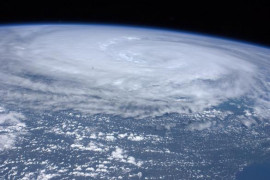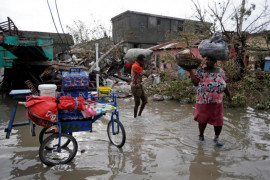
With modern technology, people can watch hurricanes churn in real time and forecasts are on-target up to seven days in advance -- but experts say some puzzling storm traits are harder to solve.
Using hurricane hunter aircraft, converted military drones, weather balloons and satellites that examine cyclones under various angles, "our observations are really telling us what is happening now," says Frank Marks, director of the Hurricane Research Division at the National Oceanic and Atmospheric Administration. "And also those observations are phenomenally useful to improving our ability to predict," he told AFP in an interview.
Hurricane Matthew becomes powerful Category 5 storm
All the collected data is immediately transmitted to meteorologists and entered into computer models that produce forecasts at the National Hurricane Center in Miami, Florida. Marks describes forecasts as simply "what we think might happen," saying experts' ability to make them has "improved dramatically for the last 35 years."
When he began his career in 1980, forecasts could look ahead about two days. Now, they are can project what may be on the way a full week in advance. Forecasts are honed as storms approach land, enabling the authorities to better evaluate the need for evacuations, says Marks, who was readying a new eight-hour observation flight overnight Thursday-Friday.
According to NASA, some 100 million people live at least 50 miles (80 kilometers) from a coastline and are therefore potentially at risk of a powerful hurricane. Even though predictions of hurricanes' paths have improved, forecasting storms' intensity remains a problem. Experts still do not fully understand why some five percent of tropical storms suddenly accelerate and become hurricanes. Matthew, for example, became a Category One hurricane on September 30, the lowest on the 1-5 scale.
Within 18 hours, it had strengthened to a Category Five hurricane with winds of more than 125 miles (200 kilometers) per hour. "Even if science were perfect, even with all the right equations, we cannot forecast rapid intensification because there is an element of what appears to be randomness," said Owen Kelley, a research scientist at NASA's Goddard Space Flight Center.
"We cannot perfectly measure the initial state of the atmosphere, the temperature and wind," he added. "So in some situations, it will make the forecast wrong." This "weakness of the system" was only fully realized about 10 years ago, he said.
He also pointed out that sometimes, forecasts about landfall remain uncertain until the very last hours. In the case of Matthew, forecasts at one point on Thursday showed it could hit Florida within 12 hours. But Kelley said the Category 4 storm was approaching the coast at an angle, which could have brought it to land up to six hours earlier and 60 miles closer or further than expected.
Knowledge about the role of global warming in the formation of potent hurricanes has improved over the past decade, but is also not fully understood, Marks said. Some of the variation in hurricanes, from active seasons seen in the 1940s and 50s to less active periods of the 1970s and 80s, come down to fluctuations in the North Atlantic Oscillation, a weather phenomenon that influences atmospheric pressure.
Hurricane Matthew kills 26, bears down on Bahamas, US
"Over the last 35 years, I have not seen any signal that there has been a notable change," said Marks, cautioning that he is not a climate scientist. "But I think 30 years is probably too short for looking at this kind of thin




































































COMMENTS
Comments are moderated and generally will be posted if they are on-topic and not abusive.
For more information, please see our Comments FAQ